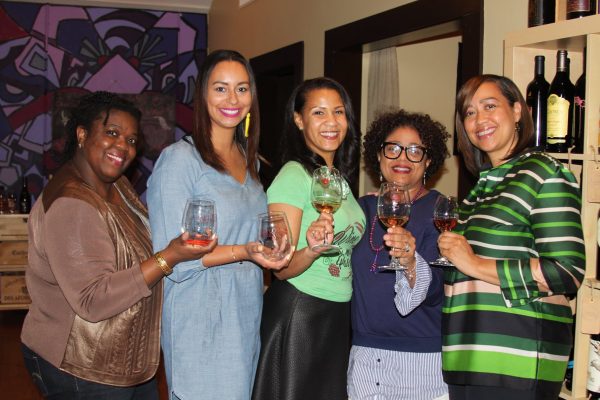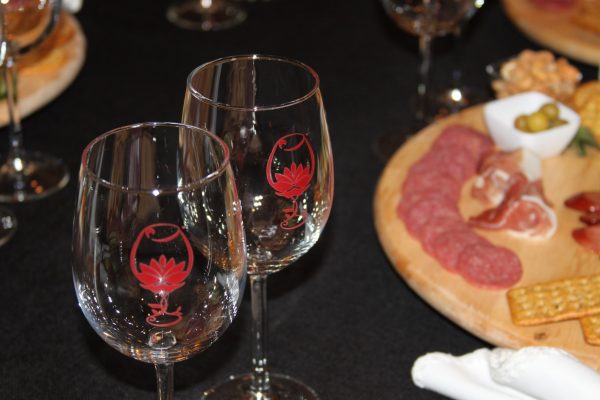Wine Tips & Tricks: The TLTV Way
Every trade has tips and tricks and Wine Friends, and we have some for you! Whether it’s saving your favorite white button down from a happy hour foul or uncovering “safe” wines for wine lovers of all levels, we’re sharing 10 tips we’ve learned over the years.
- Keep your palate and your mind open. The only way you can expand your palate is to try wines you haven’t had before. You can read about a wine all day, but until you’ve tasted that wine, you don’t truly get the full experience.
- When you can shop a local Wine Shop, Do It!

Visiting with one of our favorite wine shops, the Purple Corkscrew. Not only does this allow you to spread the Wine Love in your community, it also offers you a better chance of getting access to more esoteric, and harder to find wines, than stopping into your nearest grocery store. While you’re at it, add yourself to their mailing lists. You never know what (free *cough*, *cough*) events you might learn about. Plus, there’s nothing like enjoying a bottle purchased from shop owners who genuinely care about wine!
- What makes Fine Wines more expensive? So, you’re at your favorite Wine Shop, and looking at the shelves in front of you. Usually, the Wines get more expensive as you look at the top shelves. What makes these wines more expensive than the ones you see on the bottom shelf? Well, there are A LOT of reasons, but I will simplify it to Real Estate, Production Methods and Labor.
-
- Real Estate: there are many notable, world renowned regions (Bordeaux, Burgundy, Champagne, Barolo, Napa Valley to name A FEW), that command a higher price point, because of their vineyards’ location, soil, climate, and history of making amazing wines.
- Production Methods: Here’s an example, if the Wine went through oak aging, did it age in oak barrels which are super expensive? Or, was it mass produced and the wine was aged with oak chips or oak staves which are way more cost effective
- Labor: Were the grapes that made the Wine hand-picked, and hand-sorted, or were they mechanically harvested? It costs more money to employ people to do these tasks, thus costing a higher price point. This tip was longer, but necessary to share!
-
- When running errands, leave your wine shopping last. On shopping and errand trips, treat wine like you would treat meat and produce by making the trip to the wine shop your last stop. If you leave wine in the car too long, you’ll cook the wine and ruin it.
- Chill in a hurry with a Slurry. Because you all are some of my favorite people, here’s another Wine tip that will come in handy year-round. Use a “Slurry” to quickly chill that bottle you just picked up and carried to a friend’s house. A slurry consists of 2-parts ice, 1-parts water, and a healthy dose of salt. You want the ice to be able to move around freely. Place this mixture in a bucket and the wine bottle in with it. Submerge the bottle and twist it. Within 10 minutes you will significantly chill the wine to enjoy.
- Food Pairing for Sweet Wines. Spicy foods pair well with sweeter, more fruit-forward wines. Sweet wines tend to be lower in alcohol which is great for spicy food. A wine with high alcohol exacerbates the heat in spicy food making it unenjoyable. The sugar in a sweet wine softens the heat in spicy foods as well. When pairing Wine with desserts, pair sweet dishes with sweeter wines as they accent each other.
- Food Pairing: Select foods and wines that come from the same region. One example we love is a glass of Albariño with seafood. This grape comes from the Rías Baixas Region of Spain. Due to the location of Rías Baixas on the gorgeous coast of Galicia Spain, seafood is abundant throughout the region. This makes Albariño the signature white wine that pairs to perfection with nearly every seafood dish.
- Stemware matters. O, yes it does! We went in depth with one of latest Wine Clue Wednesday posts over on Instagram.

We sip in style—straight from our signature glasses. Use flutes for sparkling wines as they allow the bubbles to last longer. Use traditional wine glasses for white wines and lighter bodied reds because these wines don’t need much help opening up with oxygen exposure. Use larger bowled glasses for those reds wines with high tannin to soften them and make them more approachable and enjoyable.
- Keep house wine on deck—for both dinner guests and last-minute gifts. The safest wine to gift is one that you know the recipient already likes/loves. However, if you don’t know, there are several that have proven to be crowd-pleasers. Wines that are fruit forward in nature, are usually a safe bet, as they are more approachable on the palate. While you’re at it, let Wine be your passport, and take the recipient to a part of world they may not be familiar with through wine! If all else fails, kick the party off with some bubbles. Check out the quick list here that we curated of “safe” wines.
- Keep calm and save your clothes from red wine stains. When out and about, blot as much of the stain away then cover the stain with salt. As the salt dries, the stain will disappear. If at home, cover the stain in white vinegar. Immediately after applying the vinegar, rub in liquid detergent, wash in hot water and you’ll be back to fresh and so clean.
- Uncovering tipping etiquette. In the spirit of keeping it classy, we can’t forget about tipping for service at restaurants. In the US, the tipping standard is 18-20 percent. Keep in mind that we should be tipping on what the bill is before any coupons, or free drinks or food items.
- Wine Pronunciation: Say it loud and proud. Here’s a hack that I used in the start of my wine journey: Use Google to search pronunciations. If you’re in a noisy place or unable to put your phone to your ear, simply point to your wine choice on the menu and allow the server or sommelier to pronounce it for you.
- Corkage 101: Did you know that some fine dining restaurants allow you to bring your own wine? Now, before we go rush to buy a value wine and take it to your favorite steakhouse let’s talk about a few things:
-
- Corkage Fees: This fee can range from $20 to $30 plus, and includes opening, presenting, and decanting (if necessary) your wine.
- Call before your visit to ensure the restaurant offers this service and the exact price
- Take a “Special” Wine: Vine Tribe, remember that this is a way for you to enjoy a wine special to you and unique to the restaurant. With that, don’t bring a bottle of wine that the restaurant offers. Not only is it poor etiquette, it will make for an awkward situation. Some types of wine I’d suggest are ones you’ve purchased abroad, a winery-only wine, or a wine that you’ve been holding onto with an older vintage.
- Keep it Cute and Classy: This is not an opportunity to save money, but to truly enjoy a sentimental wine.
-
- Smelling Wine Hack: Over our journey, we’ve learned that tasting wine is a process. And, with that sight, smell and taste are all involved in this process. In regard to smell, to combat other odors around you, first place your hand over the glass, then swirl the wine, and smell.I also advise leaving the heavy perfume and wine at home because it will hamper yours and others experience around you.
Trust us, this is only the beginning of our tip list. We have more installments to come. Share in the comment section below some wine tricks you’ve learned!

